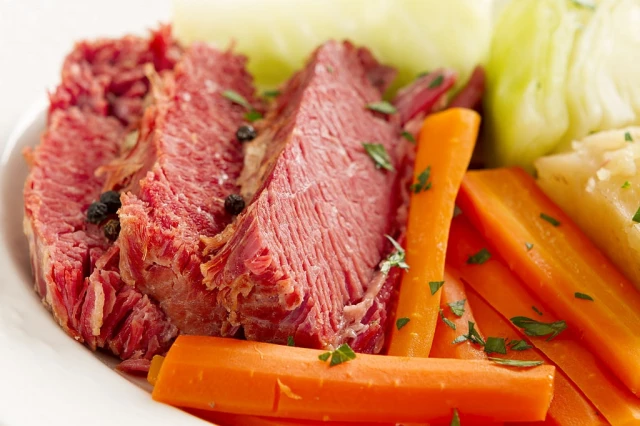Corned beef is cured brisket of beef incorporated in various traditional cuisines. It remains a delicious deli staple all year round. Corned beef goes wonderful in sandwiches, savory rolls, and sometimes served with fried vegetables. However, many people get confused that is there corn in corned beef, as its name suggest.
So, is really corned beef has corn in it and why it is called so? Corned beef has become a topic of interest because of its popularity at St. Patrick’s Day and Jewish deli. And there’s too much to explore about it for instance, how is it made and what is the history behind its name? so, let’s find out these facts.
Is There Corn In Corned Beef?
And the answer is no. Corned beef has no corn in it at all. But its name always creates confusion and it has also some historical facts behind it that we’ll discuss in a moment.
Corned beef is made by using large salt grains. In ancient times, these large grains were well known as corns. And these grains may be of wheat and rice, but they are overall referred to as corn.
This way, corned beef gets its unusual name having deep routes hundreds of years back.
So, What Does Corn Really Mean?
Corned beef is called so because of its curing or preserving method. During production, beef briskets are treated with large kernels of salt or pellets of rock salts to be exact.
This rock salt keeps briskets preserved and resistant to bacterial spoilage. And these large salt pellets or kernels were historically known as salt corns.
Corn was a general word specified for small seeds just like wheat, rice, and oats. Since, salt pellets resemble much the kernels of wheat, and rice so they are named salt corns.
So, corned beef doesn’t get its name from real corns but from the ancient word corn that means large kernels or seeds of grains.
Although its name is a bit confusing for people but it is routed too deep to be changed. So, its name is stuck as-is without any change.
Short History of Corned Beef
The real origin of corned beef is still unknown but it is believed that it evolved when people started the practice of preserving meat using salt.
These methods of meat preservation were called corning or salt curing. Besides using salt corns, saltpeter or corns of potassium nitrate were also used to cure the meat. The extensive practice of meat curing was found in the Middle East and ancient Europe.
Between 17 to 19th century, Irish corned beef was extensively made and transported for British and America because of its preserved nature.
However, corned beef loses its importance in the early 20th century than past because of its prohibitive cost. But nowadays it has gained its popularity again as a star ingredient of several traditional delicacies.
Can You Cook Corned Beef With Corn?
Yes, you can. You can cook corned beef in various exciting ways that go amazingly satisfying and yummy.
As we all know corned beef isn’t associated with real corn in any aspect. So, if you want to add real corns in it, you can do so freely.
Moreover, adding corn to your beloved beef briskets isn’t a bad idea but works really great when you have corn on hand.
For that, put corned beef in a skillet and sauté for 2 to 3 minutes. Add spices, flavorings, vegetables, and corn to it and stir properly.
Adding tomato sauce is totally optional and up to your taste preferences. Serve this hearty meal hot with white rice.
How Is Corned Beef Made?
The primary step of preparation involves curing or salting beef briskets and it can last for six to eight days. In industries, beef is cured in large barrels with spices, herbs, flavorings, and water.
In addition, the same curing process can also be performed in home where one can cure the beef in jars. After curing, next is the simmering and draining step that ultimately gives meat its characteristic flavor.
Why Is Beef Brisket So Pink?
And its answer lies again in its curing procedure. As you know beef briskets are cured in a brined water with several spices that give beef its umami flavor but impart dull brown color that looks undesired and unappetizing.
Therefore, nitrates or nitrites are added to brine for eye-catching color. Nitrates react with beef myoglobin and form nitrosomyoglobin imparting a light pink color to the corned beef.
Read Also: Maki Vs Temaki
Some Ways Of Cooking Beef Briskets
Corned beef comes into play when you want a satisfying, palatable, and quick meal straight on your plate. There are a variety of ways by which you can get a hearty meal within minutes.
For instance, incorporating beef into mac and cheese, sandwiches, and wraps is the best way of enjoying savory treats.
Moreover, corned beef pairs well with fried vegetables like cabbage, potatoes, broccoli and even corn.
And nothing is more satisfying than a grilled cheese burger or savory roll along with beef briskets.
Besides this, beef also makes savory dips, soups, and casseroles worth-eating and delicious.
Quick Wrap Up
There is no corn really incorporated in corned beef but it’s only a historical name. In ancient times, large salt grains used to cure beef were named corns. Therefore, the final product gets its name. Since this name routes back in past, so it stuck up still without any change.
You May Also Like: What Vegetables Are Man Made ?
